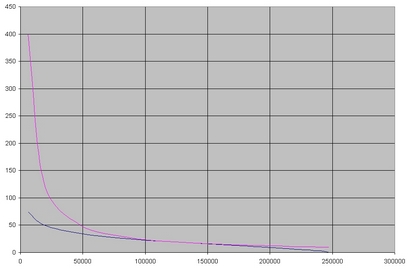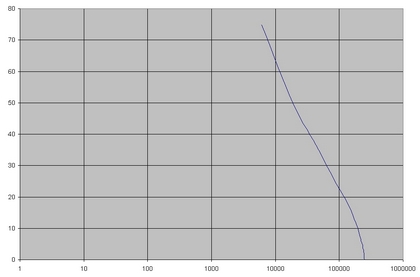The law of logarithm of salaries.
Again I came across a very interesting document “Distribution of the number of employees by salary. Russia, Tyumen region,
Yamalo-Nenets Autonomous District, April 2005 ”. Since my previous mathematical calculations of the "wealth ratio" caused a discussion, the note itself was much more interesting, I ventured to switch from coefficients to laws. So, meet, "The law of logarithm salaries."
Based on the data from this document, we will construct a graph of the value of salary by rank (employee’s number in the salary rating)

At first glance, the seemingly classic Zipf distribution. But it is worth trying to build a real Zipf curve from the source data (for example, according to the usual 20% cut off from the Pareto rule), as we immediately see that this is not so.

')
But let's try to change the scale on the X axis to logarithmic.

What is it? Almost perfect straight line! It turns out that salary is logarithmic ! And you can even calculate the size of the increase! With a decrease in rank by half, the salary increases by 10,000 rubles, or ~ $ 400!
We draw conclusions for workers and employers. They seem to be contrary to everyday logic, but rather interesting.
We presume that, according to Zipf’s law, the efficiency of workers is inversely proportional to the rank and, having taken the efficiency ratio equal to 1, we get the following.
Employees.
If you work in a business firm and are not a relative or mistress of a director and perform work that can be at least measured or assessed,
if you get $ 1000 and work twice as better, you will get not $ 2000, but about $ 1400.
If you work better 4 times, you will get about $ 1800.
If you already get $ 3,000, then you are about 30 times more efficient than someone who receives $ 1000. But if you start working twice as better, you’ll only get about $ 400, at best $ 500, and if you start working twice as bad, you can get somewhere $ 400 less.
If you get 400 and will work twice as bad, you will most likely be kicked out :(
To request a surcharge of $ 100, you need to work at least 25% better.
Employers.
The growth of the efficiency of the best workers dramatically exceeds the growth of their salaries. Therefore, any costs of luring the best employees from competitors and stimulating their best will pay for themselves many times, if only they were really the best.
Mediocre workers, the majority of whom, any effects through payment, both incentive and punitive, are ineffective.
It is useless to rehabilitate bad workers, it is cheaper to get rid of them.
By the way, these conclusions are repeated many times by all preachers of start-ups and progressive methods of managing firms, oddly enough, only with a different sauce.
Yamalo-Nenets Autonomous District, April 2005 ”. Since my previous mathematical calculations of the "wealth ratio" caused a discussion, the note itself was much more interesting, I ventured to switch from coefficients to laws. So, meet, "The law of logarithm salaries."
Based on the data from this document, we will construct a graph of the value of salary by rank (employee’s number in the salary rating)

At first glance, the seemingly classic Zipf distribution. But it is worth trying to build a real Zipf curve from the source data (for example, according to the usual 20% cut off from the Pareto rule), as we immediately see that this is not so.

')
But let's try to change the scale on the X axis to logarithmic.

What is it? Almost perfect straight line! It turns out that salary is logarithmic ! And you can even calculate the size of the increase! With a decrease in rank by half, the salary increases by 10,000 rubles, or ~ $ 400!
We draw conclusions for workers and employers. They seem to be contrary to everyday logic, but rather interesting.
We presume that, according to Zipf’s law, the efficiency of workers is inversely proportional to the rank and, having taken the efficiency ratio equal to 1, we get the following.
Employees.
If you work in a business firm and are not a relative or mistress of a director and perform work that can be at least measured or assessed,
if you get $ 1000 and work twice as better, you will get not $ 2000, but about $ 1400.
If you work better 4 times, you will get about $ 1800.
If you already get $ 3,000, then you are about 30 times more efficient than someone who receives $ 1000. But if you start working twice as better, you’ll only get about $ 400, at best $ 500, and if you start working twice as bad, you can get somewhere $ 400 less.
If you get 400 and will work twice as bad, you will most likely be kicked out :(
To request a surcharge of $ 100, you need to work at least 25% better.
Employers.
The growth of the efficiency of the best workers dramatically exceeds the growth of their salaries. Therefore, any costs of luring the best employees from competitors and stimulating their best will pay for themselves many times, if only they were really the best.
Mediocre workers, the majority of whom, any effects through payment, both incentive and punitive, are ineffective.
It is useless to rehabilitate bad workers, it is cheaper to get rid of them.
By the way, these conclusions are repeated many times by all preachers of start-ups and progressive methods of managing firms, oddly enough, only with a different sauce.
Source: https://habr.com/ru/post/1235/
All Articles